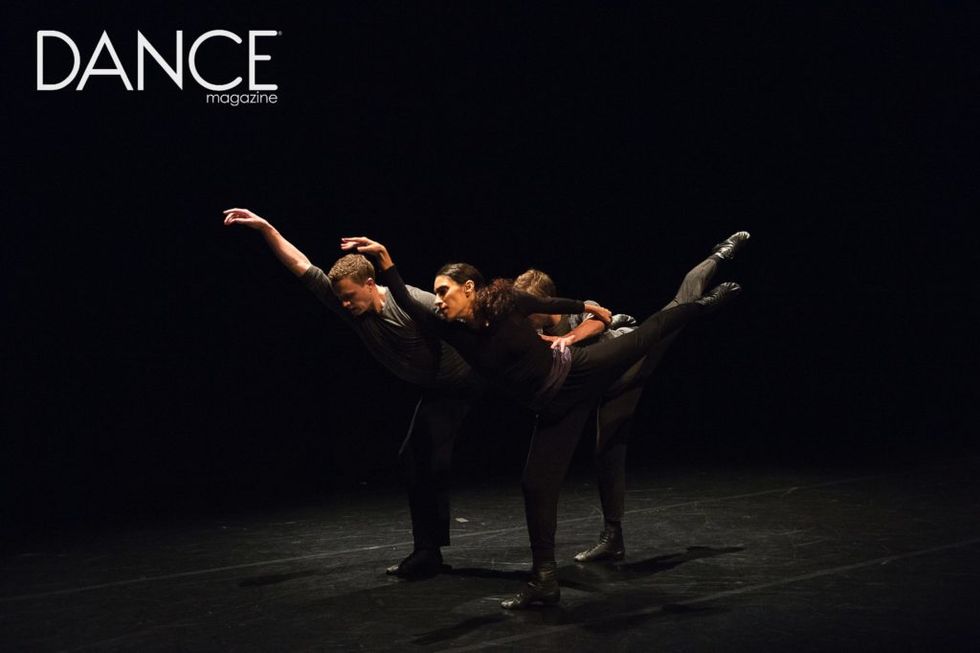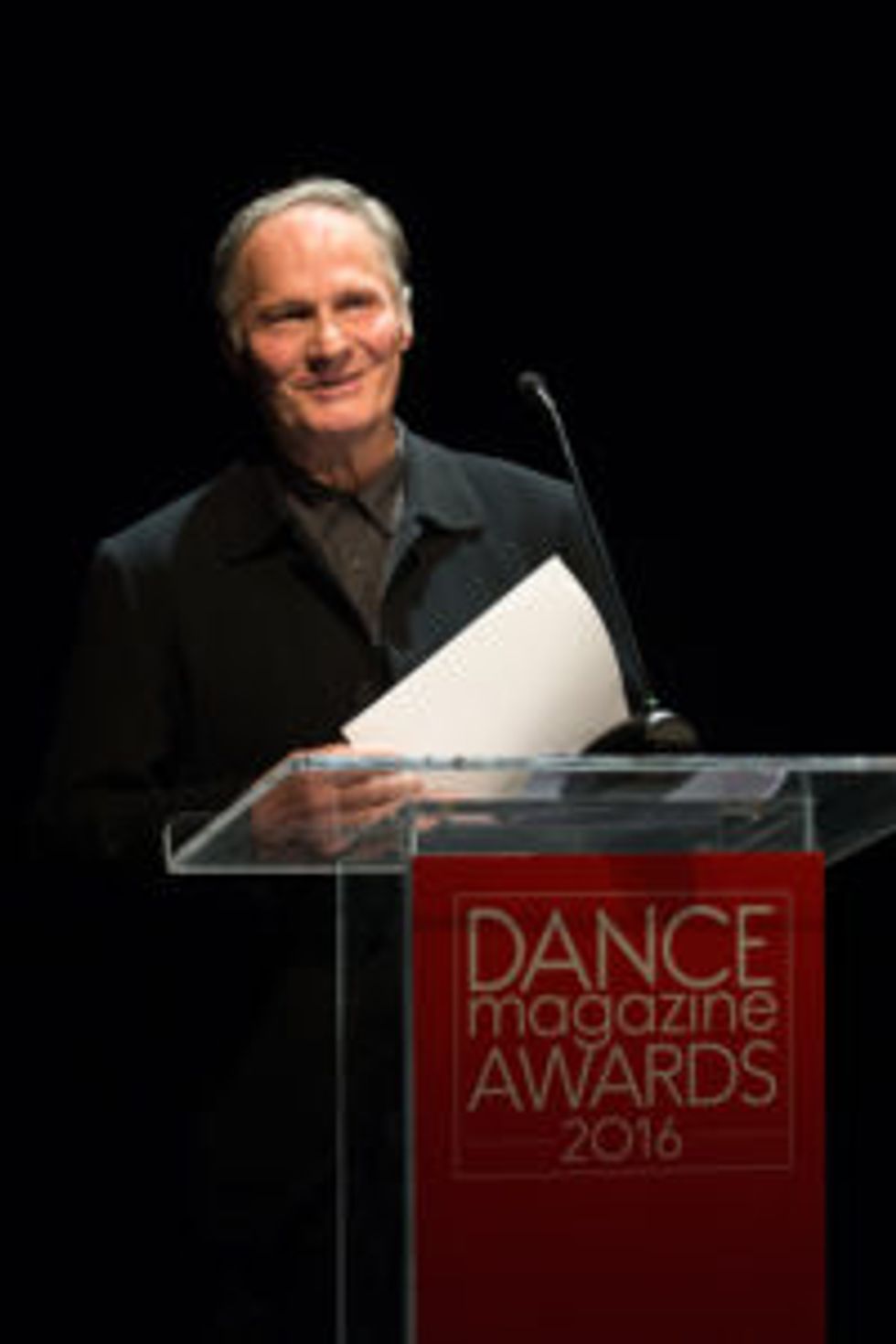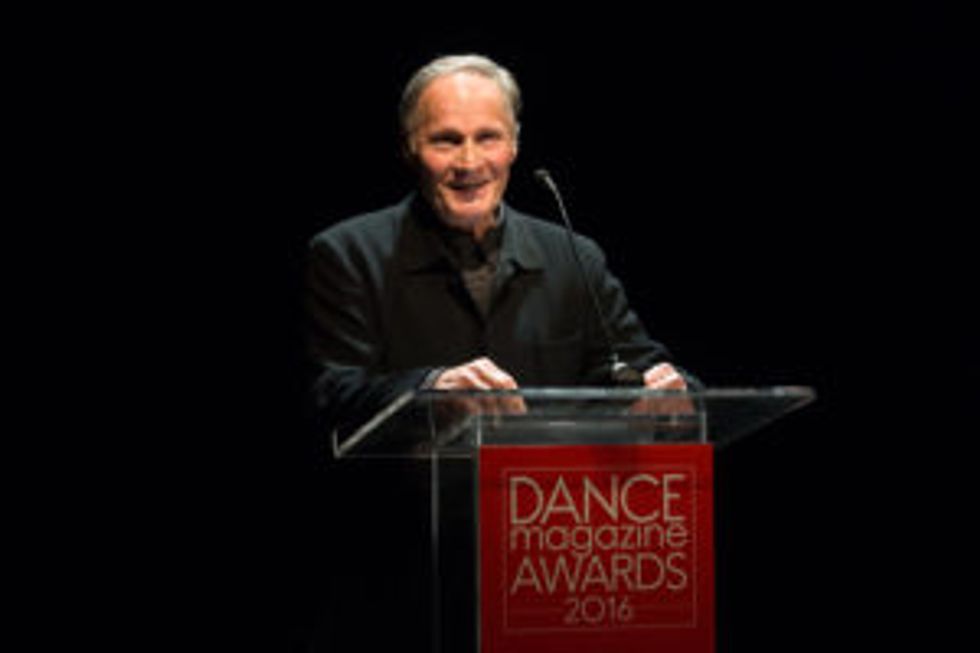Lar Lubovitch: Why I Want To Boldly Go Where No One Has Gone Before

Lar Lubovitch at the 2016 Dance Magazine Awards. Photo by Christopher Duggan.
Lar Lubovitch gave such a moving, thought-provoking speech at the Dance Magazine Awards this December that we felt compelled to share it with readers who weren’t there. He gave us permission to present the entire text here.
At the age of 3 or 4 years old, I danced for the first time. It was a spontaneous a reaction that arose in me involuntarily in response to a fire.
My early life was spent in an area of Chicago known as Maxwell Street. It was Chicago’s equivalent of New York’s Lower East Side.
We lived in a second-floor apartment whose windows looked directly across the street into the second-floor windows of a Woolworth’s five and ten cent store, sometimes referred to as the dime store.
One freezing winter night the dime store erupted in flames. Fire engines wailed through the night and inundated the conflagration with water.
In the morning when I awoke and looked across the street, giant cascades of water, gushing through the second story windows, had frozen solid into great arching waterfalls. And trapped within the gleaming cascades were tiny toys, tubes of lipstick, various little kitchen gadgets and pieces of broken dolls…but especially, one teddy bear, staring directly at me from within his ice palace suspended forever in crisis.
Something overwhelming happened in my body…an excitement too powerful to contain, that set me in motion.
I became the teddy bear—first singed by the fire, then lifted by the water, and then trapped within his frozen eternity.
I made up a dance for the first time. I don’t know why I expressed my excitement at seeing this fantastical vision by dancing. I just did.
It was from a place before thinking.
Martha Graham put something like that into words:
“There is a vitality, a life force, a quickening that is translated through you into action and because there is only one of you in all of time, this expression is unique.”

Lubovitch’s The Wanderers at the Dance Magazine Awards. Photo by Christopher Duggan
I am not really sure why we dance, but it appears to be part of human nature that our bodies take over when something inexpressible needs to be said.
Primitive man, when faced with the mystery of what made water fall from the sky, that made crops grow so that they could eat, envisioned a power above them to which they could appeal for rain. They raised their arms to plead, they swayed and jumped, they fell to their knees in supplication.
And dance and God were given form at the same time.
Over the centuries humankind danced for many reasons: as a form of worship, as celebration, as a way of mourning, an expression of tribal identity, a social convention, as flirtation and seduction.
Ancient Egyptians recorded dances in hieroglyphics as a record of their history and beliefs.
Greek warriors danced in unison as a way to unite as one before going into battle.
Salome danced in exchange for the head of John the Baptist.
In the 13th century in Italy, the Tarantella was forbidden by the church, and its dancers were accused of demonic possession.
At about the same time, a disease called “Tanzmania” swept through Germany.
In the 1890’s“Little Egypt” shocked the western world with her x-rated belly dancing.
A couple of decades later, a spy named Mata Hari danced to sabotage the enemy.
But long before that, Louis XIV danced to let all of France know that he was king of the sun. And his courtiers were required to learn to dance in order to secure his favor.
And right about then—give or take a hundred years or so—dance crossed a line and became something it had not been before. It became an art.
The arts of music, painting, sculpture and architecture had already existed for thousands of years. But once dance found its calling, it made up for lost time and grew very quickly from a manner of social behavior to the highly-evolved mode of expression we are celebrating tonight.
Of course, it didn’t happen all at once. Dance became an art form the way a dance becomes a dance: By fluidly connecting a series of events, each event a thing in itself, but also the source from which the next event is born, each step along the way the summation of all that preceded it and simultaneously the mother of the step that follows. Always flowing forward but always referential to its past. Just as all of we who dance and make dances today are the sum of all that came before us.
My contemporaries and I were privileged to be the first generation of heirs to the legacies of innovators such as Balanchine, Graham, Tudor, Limón and Cunningham.
We are likely to think that those creative giants arose from nowhere, sudden genius, a departure from all that came before. But even geniuses such as those were the sum of all things that preceded them, until they took that unexpected leap of the imagination that opened a pathway to a future that had been unimagined by others.

Lubovitch’s The Wanderers at the Dance Magazine Awards. Photo by Christopher Duggan.
All of us who dance and make dances are irresistibly drawn to that challenge—the obligation really—to engage in the act of discovery, to strive to find one’s truthful voice, to be willing to risk, to take the million incremental steps that eventually and inevitably lead to a breakthrough.
The history of all art absolutely affirms that no matter how far we think we have come there is always another way, a new way, a better way, a further thought, an original vision, a startlingly different leap of the imagination taken by the one—that was unanticipated by the many—that elevates and changes the depth and breadth of creative possibilities.
During the 50 years that I have been creating dances, I have witnessed a number of great dance makers along the way that have added to and altered the look and reach of dance in new and surprising ways since the bedrock was laid by the earlier 20th-century visionaries that inspired their journeys.
When one embarks upon or is irrevocably driven to a life as an artist, the imperative to create something new and original is inherent. It is coded in the DNA of art. A natural creator does not need to be told, it is simply understood that is the very definition of what an artist does.
It takes a lot of courage to voluntarily dive into the unknown with only one’s intuition as a guide, not to mention “chutzpah.”
One may hope and pray for the elusive muse to arrive and when she does it feels miraculous, as though the dance is being revealed rather than invented.
But when she doesn’t—which is more often than not—then the energy of fear must be put to use…and making a bargain with Satan is not too low to stoop.
Whether it is the cerebral heights of Balanchine revealing what music looks like, or Martha Graham’s passionate essays on the human heart, or a universe of exquisite accidents as proposed by Merce Cunningham, or all the generations of dance makers that followed, the common thread that binds all of those souls together is that through the drama of line, shape, time and motion, all have attempted to say what is, to them, most truthful—and therefore most beautiful.
It may be that every dance I have ever made is an attempt to recapture the dance of the teddy bear— the moment of passion, the rapture, the freedom, the exhilaration that only dance could embody for me.
But with whatever I was given—some might call it a gift—I have done the best that I can. I will leave it to others to grade my score card when the tally is given. But whatever the measure of my contribution, I can say with great certainty that I have been true to myself whatever the prevailing fashion, and that I have loved and respected dancers and they have loved and inspired me in return.

Lar Lubovitch. Photo by Christopher Duggan.
At the age of 73 my aching damaged body is begging me to stop, but my mind has not yet been willing to cooperate with that plea.
“Maybe the next one will be the one…the one where I finally get it right.” That’s the thought that has goaded and driven me through all these terrible, fantastic years.
But whether in the best or worst of times I would be remiss, we would be remiss, if we did not acknowledge that we have been privileged to have been allowed a life in dance.
You may be surprised to know that I have been a life-long Trekkie.
I have seen every TV episode and Star Trek movie ever made of the voyages of the Starship Enterprise.
What captures my imagination and why I gleefully follow every voyage is the mission stated by Captain Kirk at the beginning of every episode: “To explore strange new worlds, to boldly go where no one has gone before.”
For obvious reasons, every time I hear that I am hooked.
Whether or not I have succeeded in going where no one has gone before is a matter of conjecture. But that I have been engaged in that act of magical thinking and remained committed to the voyage for 50 years is the spirit in which I gratefully receive the acknowledgment being afforded me tonight by my colleagues at Dance Magazine.
I am humbled to be added to the list of superb artists who have received this esteemed award, and offer my gratitude for the affirmation.




